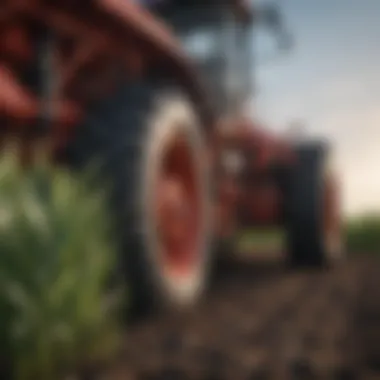Exploring Modern Farming Practices and Sustainability


Intro
The landscape of agriculture today is remarkably different from what it was a few decades ago. Agronomy has evolved into a complex interplay of various techniques, technological advancements, and sustainability practices. Farmers face an ever-changing environment marked by economic pressures, climate change, and the demand for food security. This article aims to untangle the dynamic elements of modern farming practices, focusing on the roles, techniques, and issues that define the field in the contemporary era.
Latest Trends in Agriculture
Overview of Current Trends
Recently, several trends have emerged in agriculture. These trends are reshaping how farmers approach their land and crop management. One notable trend is the increasing interest in precision farming. Farmers now utilize data analytics to monitor crop health, soil quality, and water usage. This method allows for better decision-making and can lead to increased yields.
Another significant trend is the rise of organic farming. Consumers are more aware of food sources, leading to a demand for organic produce. Farmers are adapting by converting their conventional farms into organic ones, focusing on natural inputs and sustainable cultivation practices.
Impact of Technology on Farming Practices
The integration of technology in agriculture cannot be overstated. Technologies such as drones and satellite imaging provide critical insights into large agricultural areas. Farmers can now assess crop conditions and irrigation needs quickly and efficiently. This not only saves time but also promotes resource conservation.
Furthermore, equipment like automated tractors and planting machines is becoming prevalent. These innovations reduce labor costs and increase efficiency. Technology also plays a role in pest management, with smart solutions that minimize chemical use while maximizing crop health.
"The modern farmer is not just someone who works the land, but a data analyst, a technologist, and a sustainability advocate."
Sustainable Practices: Towards a Greener Future
Importance of Sustainability in Agriculture
Sustainability is an essential focus for modern farming. As environmental concerns grow, farmers recognize their responsibility to protect the ecosystem. Sustainable practices not only help in preserving soil health but also work towards reducing pollution and resource depletion.
Methods for Sustainable Farming
There are various methods farmers use to promote sustainability. Crop rotation helps prevent soil exhaustion, while cover cropping enhances soil vitality. Additionally, agroforestry, which integrates trees with crops, has benefits for biodiversity and soil preservation.
Farmers are also turning to renewable energy sources. Wind turbines and solar panels are increasingly situated on farms, providing energy independence and reducing carbon footprints.
Gardening Techniques and Tips
Essential Gardening Tools and Equipment
For those interested in gardening, having the right tools is crucial. The basic tools needed include:
- Trowel
- Pruning shears
- Hand fork
- Garden hose or watering can
These tools help maintain the garden and ease various tasks like planting and pruning.
Seasonal Gardening Practices
Understanding seasonal cycles can greatly improve gardening results. Each season brings its unique demands. In the spring, it's vital to prepare the soil and begin planting. Summer requires more frequent watering and pest management. Autumn is the time for harvesting and preparing the garden for winter, while winter can be used for planning and maintaining tools.
This alignment with seasonal changes ensures that both crops and gardens thrive throughout the year.
As agriculture continues to develop, staying informed and adaptive becomes essential. Understanding these dynamics not only enhances farming practices but also contributes to broader environmental goals.
Understanding the Role of Farmers in Agriculture
Farming is the cornerstone of human civilization. It sustains populations and provides for communities. Understanding the role of farmers in agriculture is essential for grasping the broader dynamics of modern farming practices. Farmers are not merely producers; they engage deeply with ecological, social, and economic systems. Their decisions shape food systems, influence consumer behavior, and impact environmental health. This article explores the multifaceted contributions of farmers.
Historical Perspective on Farming Practices
Historically, farmers have been key players in the survival and development of societies. Agriculture began over 10,000 years ago with the domestication of plants and animals. Early farmers relied on rudimentary techniques and local knowledge. Over centuries, practices have evolved due to changes in climate, technology, and population dynamics.
In ancient times, farming was primarily subsistence-based. Farmers grew crops to meet their families' needs, with little surplus for trade. The advent of the agricultural revolution saw innovations like crop rotation and selective breeding. These developments not only increased yield but also laid the groundwork for modern agriculture.
Today, the understanding of historical agricultural practices provides context for current techniques and challenges. Modern farmers build on the successes and failures of their ancestors, adapting age-old strategies to contemporary needs.
The Evolution of Farmer Roles


The role of the farmer has undergone significant transformations. In past centuries, farmers operated as self-sufficient entities. They managed all aspects of production from seed selection to planting and harvesting. However, various factors have driven changes in these roles.
- Specialization: As agriculture became more advanced, farmers began to focus on specific tasks or crops, leading to increased efficiency and productivity. This specialization often means that one farmer may not handle the entire farming process, differentiating roles within farming.
- Technological integration: With advancements in technology, farmers increasingly utilize tools and equipment. Modern innovations such as GPS and data analytics influence modern farming practices. Farmers can optimize production, manage resources more efficiently, and better predict yields.
- Market dynamics: The globalization of agriculture means that farmers now operate within complex supply chains. They must navigate market demands, consumer preferences, and economic pressures. This changing landscape requires farmers to engage more with marketing and financial management.
- Sustainability concerns: Farmers now play a key role in addressing environmental issues. With a growing awareness of climate change, many are adopting sustainable practices. They must balance productivity with environmental stewardship to ensure long-term viability.
These evolving roles reveal not only the adaptability of farmers but also their critical importance in shaping the future of agriculture. As the landscape shifts, farmers remain at the forefront, influencing how food is produced and how agricultural systems function.
Core Principles of Modern Farming
The core principles of modern farming form the foundation on which contemporary agricultural practices are built. These principles emphasize sustainability, efficiency, and adaptability. Understanding these elements is crucial for farmers and enthusiasts alike. As the agricultural landscape evolves, adhering to these core principles can drive innovation and foster resilience in the face of various challenges.
Sustainability in Agricultural Practices
Sustainability is paramount to modern farming. This concept revolves around utilizing resources in a manner that does not compromise future generations' ability to meet their needs. In agriculture, sustainable practices include crop rotation, organic farming, and the use of renewable energy sources. These practices contribute to the preservation of the environment, enhance soil fertility, and increase biodiversity.
Benefits of sustainable methods include:
- Reducing dependency on synthetic fertilizers and pesticides
- Enhancing ecosystem services such as pollination and water filtration
- Improving food security and resilience against climate change
Farmers who embrace sustainability are likely to see long-term economic benefits as well. Not only do these methods appeal to increasingly eco-conscious consumers, but they also reduce operational costs over time. Sustainable practices can improve yield stability, ensuring that production remains viable against fluctuations in market demand.
Precision Farming Techniques
Precision farming, also known as precision agriculture, involves the use of technology to optimize field-level management regarding crop farming. This approach leverages data analytics, GPS, and remote sensing technology to monitor and manage the health of crops in real-time. The implementation of precision farming techniques allows farmers to apply inputs more efficiently and effectively.
Key components of precision farming include:
- Soil sampling and mapping to assess nutrient levels
- Use of drones and satellite imagery for crop monitoring
- Variable rate technology to adjust input application based on specific field conditions
The advantages of precision farming are significant. Farmers can reduce waste, lower costs, and improve crop yields by applying the right amount of resources in the right locations. This method promotes effective use of water and fertilizer, thereby supporting sustainability goals. Furthermore, as data collection improves, farmers can make informed decisions that enhance productivity and profitability.
By integrating sustainability and precision farming techniques, modern agriculture can navigate the complexities of today's market dynamics while contributing to a healthier planet.
Technological Advancements in Agriculture
Technological advancements play a crucial role in shaping the future of agriculture. These innovations not only enhance productivity but also ensure sustainability. As farmers face various challenges like climate change, resource limitations, and market pressures, the adoption of new technologies becomes essential. This section examines specific elements of technological advancement that significantly impact modern farming practices.
The Role of Data Analytics
Data analytics is transforming the farming landscape by providing farmers with critical insights. With the help of data, farmers can make informed decisions regarding resource allocation, crop selection, and management practices. By analyzing historical weather data, soil health metrics, and market trends, farmers can optimize their operations.
- Precision Agriculture: This concept involves using data to guide planting and harvesting decisions. It leads to better yield forecasts and reduces waste.
- Predictive Analytics: This aspect allows for anticipating pest outbreaks or disease, enabling preemptive action.
Incorporating data analytics into farming practices increases efficiency and can result in significant cost savings. By leveraging these insights, farmers can not only increase their profits but also contribute to sustainable practices.
Automation and Robotics in Farming
Automation and robotics are revolutionizing how farming tasks are performed. Mechanization reduces the demand for manual labor, which is often hard to find. Additionally, robots can work more consistently than humans, minimizing errors.
- Examples of Automation:
- Robotic harvesters can operate efficiently during peak seasons.
- Drones are used for crop monitoring and application of pesticides.
These technologies allow farmers to cover larger areas with greater precision. However, the initial investment can be high, and farmers need to evaluate whether the long-term benefits outweigh the costs. Still, as these technologies evolve, they are likely to become more affordable over time.
Innovations in Crop Management
Crop management is essential to maximizing yields while minimizing environmental impact. Recent innovations in crop management techniques enable farmers to optimize their practices effectively.
- Biotechnology: The development of genetically modified organisms (GMOs) improves resistance to pests and diseases. This innovation can lead to higher productivity and reduced reliance on chemicals.
- Integrated Pest Management (IPM): This approach uses a combination of biological, cultural, and chemical practices to control pests sustainably.
- Smart Irrigation Systems: These systems use sensors and real-time data to optimize water use, thus conserving resources.
Incorporating these innovations helps in achieving sustainable agricultural practices. As a result, farmers are better equipped to address the growing demands for food production without compromising the health of the planet.
"Adopting technological advancements in agriculture not only increases efficiency but also contributes to a more sustainable future for farming."


Environmental Considerations
Environmental considerations are crucial in the discourse of modern farming practices. The sustainability of our agricultural systems directly correlates with the health of ecosystems, water resources, and soil quality. In this context, the interplay between farming and environmental stewardship becomes apparent. Modern farming must adapt to mitigate environmental impacts while maximizing productivity.
Impact of Climate Change on Farming
Climate change poses significant challenges to farming. Rising temperatures and erratic weather patterns affect crop yields and livestock health. Farmers are forced to reconsider their strategies to cope with these changes. A shift in planting dates and crop varieties is necessary to align with new climate realities.
In addition, extreme weather events such as floods and droughts can devastate crops. Farmers need to become adaptable, employing risk management strategies. Implementing robust irrigation systems and selecting drought-resistant crops will be vital.
Moreover, the increased prevalence of pests and diseases can be attributed to climate change. Warmer temperatures create favorable conditions for pests, which can lead to greater crop damage. Therefore, integrating pest management practices that consider environmental conditions is now more important than ever.
Soil Health and Management Practices
Soil health is fundamental to successful farming. Healthy soil contributes to efficient nutrient cycling, increased water retention, and enhanced microbial activity, all of which are essential for robust crop growth. Managing soil health involves practices that preserve and enhance its quality.
Common techniques include cover cropping, reduced tillage, and crop rotation. These practices help prevent erosion and promote the vitality of soil organisms. They also enhance soil structure, enabling it to support diverse plant life more effectively.
Farmers should also be aware of soil testing. Regular testing can uncover nutrient deficiencies and guide appropriate amendments, such as organic fertilizers. This targeted approach improves fertility and aligns with sustainable development goals.
In summary, effective environmental considerations in farming are vital. They not only address the immediacy of climate change but also ensure the long-term viability of farm operations through improved soil health.
By prioritizing sustainable practices and adapting to climate challenges, farmers can play an integral role in shaping resilient agricultural ecosystems.
Economic Factors in Agriculture
Understanding the economic factors in agriculture is crucial, as they play an integral role in shaping the landscape of modern farming practices. The farmers' ability to adapt to market fluctuations, embrace new technologies, and access resources directly influences their profitability and sustainability. Economic factors encompass a wide range of elements, such as market demand, pricing trends, and the availability of financial support. Together, these components create a dynamic environment where strategic decision-making becomes paramount.
In agriculture, income generation is closely linked to the ongoing changes in market trends and consumer preferences. For farmers, staying informed about these trends is not just beneficial but essential for success. They must navigate the complexities of supply and demand, often leading to fluctuations in product prices. Hence, understanding these economic signals can help farmers maximize their revenue streams and ensure their operations remain viable.
Market Trends and Farmer Revenue
Market trends significantly impact farmer revenue, making it vital for producers to stay attuned to shifts in consumer behavior. Today’s consumers are increasingly aware of the food they purchase, often prioritizing health, sustainability, and ethical sourcing. This shift has led to a growing demand for organic and locally sourced products.
Farmers need to analyze these trends to align their production strategies with market preferences. Successful farmers often conduct market research or collaborate with agricultural economists to forecast demand accurately. The cost of production—rooted in inputs like seeds, fertilizers, and labor—also must align with anticipated market prices to ensure profitability.
Additionally, understanding fluctuations in commodity prices can be critical. For example, unexpected price drops in corn or soybeans can lead to significant financial strain on those relying on these staple crops. Likewise, better-than-expected returns in niche markets, such as medicinal herbs or specialty grains, can encourage farmers to diversify their crops.
- Key considerations in analyzing market trends:
- Monitoring consumer preferences.
- Utilizing data-driven forecasting methods.
- Evaluating competitor strategies.
Access to Resources and Grants
Access to resources and grants is another important economic factor influencing modern agriculture. Numerous programs are designed to assist farmers in securing the necessary funding for their operations. Government and private grants often provide financial support to implement sustainable farming practices, adopt new technologies, or improve infrastructure.
It's essential for farmers to identify suitable grants and resources that align with their agricultural goals. Resources can include loans, grants, technical assistance, or access to educational programs. Some initiatives, like the USDA's Sustainable Agriculture Research and Education (SARE) program, facilitate research on innovative farming methods while offering financial backing.
Farmers can also tap into community resources and cooperatives. Local agricultural societies often provide information on funding opportunities, provide networking channels, and even share equipment or facilities, reducing individual costs.
- Benefits of accessing resources include:
- Enhanced financial stability.
- Opportunities for innovation.
- Strengthened community ties.
"Access to financial resources can empower farmers to embrace sustainable methods and adapt to market shifts."
Economic factors are thus a core element of modern agriculture. By grasping market trends and leveraging available resources, farmers will not only safeguard their livelihoods but can also contribute towards building a more resilient and sustainable agricultural sector.
Farming Communities and Social Impact
Farming communities play a crucial role in shaping the social dynamics of agricultural practices. These communities are not just groups of people engaged in farming; they are ecosystems that foster collaboration, knowledge sharing, and resource management. The importance of understanding farming communities lies in their potential to influence agricultural sustainability and food security. Farmers who work together can share their experiences, reduce operational costs, and increase their market reach.
In these communities, social ties are formed, creating networks for support that are vital during challenging times. For example, when faced with adverse weather conditions or pest invasions, farmers within a cooperative can provide assistance, from moral support to sharing equipment or even pooling financial resources. Healthy farming communities promote resilience and adaptability in the face of volatile market conditions or environmental shifts.


Building Agricultural Cooperatives
Agricultural cooperatives serve as fundamental building blocks for modern farming communities. These organizations enable farmers to join forces, enhancing their bargaining power. This is particularly important in negotiations with suppliers and buyers. By collectively purchasing seeds, equipment, and other inputs, farmers can reduce costs and improve their profit margins.
Moreover, cooperatives create opportunities for shared knowledge and expertise. Members participate in workshops and training sessions, which enhance their skills and understanding of best practices in farming. This exchange contributes not just to the profitability of individual farmers, but also to the health of the agriculture sector as a whole.
A few key benefits of agricultural cooperatives include:
- Strengthened bargaining power
- Shared financial resources
- Collective marketing strategies
- Access to valuable training and education
Community Support and Local Markets
The relationship between farming communities and local markets cannot be underestimated. Local support systems enable farmers to sell their produce directly to consumers, thus reducing dependence on distant markets and middlemen. This proximity fosters a sense of trust and accountability between producers and consumers.
Engaging local markets helps stabilize prices for farmers while ensuring that consumers receive fresh, quality products. Furthermore, local markets contribute to the economy by keeping financial resources in the community, which can stimulate growth in other sectors.
One aspect of community support is the rise of farmers' markets. These markets encourage direct interaction between farmers and buyers, promoting local produce and enhancing community engagement. Through such initiatives, consumers become more aware of where their food comes from. This is essential for building sustainable practices, as consumers often choose to support environmentally friendly practices.
Educational Initiatives for Farmers
Education is a cornerstone of successful farming communities. Various initiatives are designed to enhance farmers' knowledge about new techniques, environmental stewardship, and market trends. Such education helps farmers make informed decisions that impact their yield, revenue, and sustainability.
Local organizations, universities, and government agencies often provide workshops, seminars, and training programs. Topics range from advanced crop management practices to financial literacy. For instance, understanding how to efficiently manage resources can lead to not only higher yields but also reduced costs and improved profits.
Some effective educational initiatives include:
- Workshops on sustainable practices
- Online courses on pest management
- Financial planning for farmers
- Mentorship programs linking experienced farmers with newcomers
Building strong educational foundations within farming communities not only empowers farmers but also supports the overall health of the agricultural ecosystem. Such investments in knowledge are crucial for adapting to modern challenges and ensuring long-term sustainability.
Challenges Facing Modern Farmers
The landscape of agriculture is shifting, and modern farmers encounter various challenges that significantly shape their practices. Understanding these challenges is crucial for devising effective solutions. The challenges often revolve around pest and disease management, financial risks, and market volatility. Cultivating this awareness can help farmers adapt their strategies to ensure sustainable productivity.
Pest and Disease Management
Pest control and disease management are significant concerns for farmers today. A rise in pests or a new disease can quickly devastate crops and lead to substantial financial losses. Integrated Pest Management (IPM) is one strategy farmers are adopting. IPM combines biological control, habitat manipulation, and cultural practices. By focusing on preventative measures rather than just reactive ones, farmers can reduce reliance on chemical pesticides.
Maintaining soil health also plays an integral role. Healthy soil often supports resilient plants, which are less susceptible to pests and disease. Crop rotation is a key practice in this regard, offering natural pest and disease suppression. Furthermore, the use of technology—like drone monitoring—enables farmers to detect pest problems early, allowing for timely intervention.
Financial Risks and Market Volatility
Farmers today face notable financial risks due to the inherent volatility of market prices. Several factors contribute to this uncertainty, including climate changes, trade policies, and consumer demand fluctuations. Additionally, many farmers operate on thin margins, which makes them vulnerable to sudden price drops. Poor crop yields can compound these issues, leading to financial instability.
Access to resources plays a vital role in managing these risks. Financial education can empower farmers to make informed decisions regarding loans, investments, or insurance. Government grants and subsidies have begun to address this issue, offering support to mitigate risks. Understanding market trends and accessing accurate data can significantly assist farmers in making strategic choices.
"Financial literacy is essential for modern farmers to navigate the complexities of agricultural markets."
Recognizing these challenges is essential for the farming community. Addressing them effectively is key to enhancing productivity and sustainability. As farming practices continue to evolve, so too must the approaches farmers take to tackle these pressing issues.
Future Perspectives in Farming
The future of farming holds significant importance in today's rapidly changing global landscape. As populations grow, the demand for food increases. This makes it essential to explore innovative farming methods and new technologies that can enhance productivity while ensuring sustainability. Understanding future perspectives enables farmers and agricultural stakeholders to adapt their practices in alignment with emerging trends and societal needs.
Emerging Trends and Innovations
Emerging trends in modern farming reflect the adaptive nature of the agricultural sector. Currently, vertical farming is gaining momentum. This method allows crops to be grown in stacked layers, optimizing space and minimizing land use. Urban farming is also on the rise. It transforms city spaces into productive agricultural environments, bringing food production closer to consumers and reducing transportation costs.
Biotechnology is another field driving innovation. The use of genetically modified organisms (GMOs) can lead to crops that are more resistant to pests and diseases. This reduces the reliance on chemical pesticides, promoting a healthier ecosystem. Additionally, developments in plant-based proteins are changing dietary preferences. Farmers are increasingly diversifying their crop choices in response to this trend.
Furthermore, regenerative agriculture is being embraced for its long-term sustainability. By focusing on practices that enhance soil health, reduce carbon emissions, and improve biodiversity, farmers can create resilient farming systems. These practices also align with consumer preferences for ethically produced and sustainable food.
Policy Changes and Their Implications
Policy changes play a critical role in shaping the future of agriculture. Governments worldwide are beginning to recognize the necessity for reforms that align agricultural practices with environmental goals. For instance, policies focused on carbon farming incentivize farmers to implement practices that sequester carbon in the soil. This not only contributes to climate change mitigation but can also increase farmer profitability.
Support for research and development in agriculture is equally vital. Governments can fund projects that focus on innovative technologies and sustainable practices, providing farmers with the tools they need. Additionally, policies that promote access to markets help farmers secure better prices for their goods.
Agricultural subsidies are also undergoing scrutiny. As these financial aids evolve, it is critical to consider how they can support sustainable practices rather than merely incentivizing high-output, monoculture systems. The transition to a more integrated policy framework can create a more resilient agricultural sector and promote food security in the long term.







